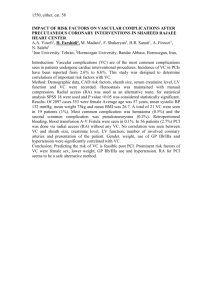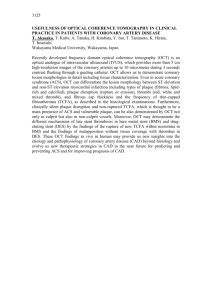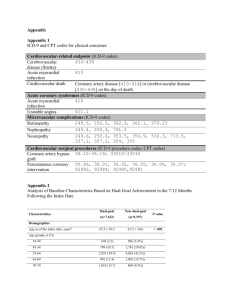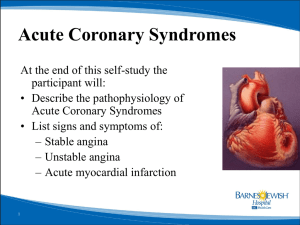The Long and Winding Road: Robert G. Xuereb, Mariosa Xuereb
advertisement
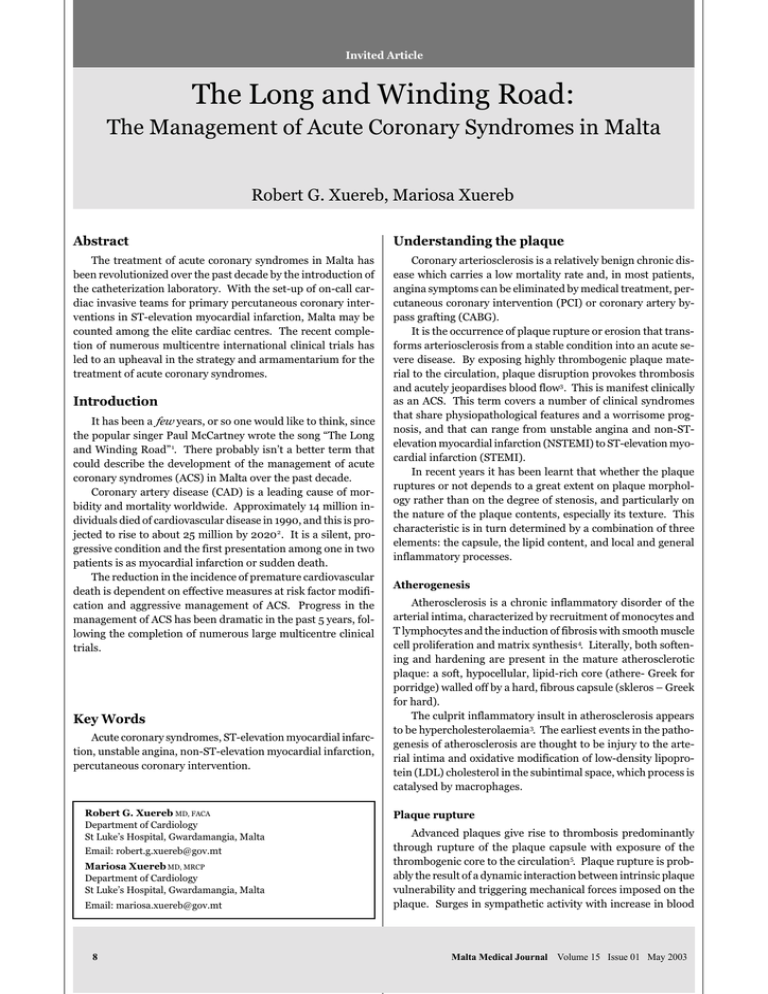
Invited Article The Long and Winding Road: The Management of Acute Coronary Syndromes in Malta Robert G. Xuereb, Mariosa Xuereb Abstract Understanding the plaque The treatment of acute coronary syndromes in Malta has been revolutionized over the past decade by the introduction of the catheterization laboratory. With the set-up of on-call cardiac invasive teams for primary percutaneous coronary interventions in ST-elevation myocardial infarction, Malta may be counted among the elite cardiac centres. The recent completion of numerous multicentre international clinical trials has led to an upheaval in the strategy and armamentarium for the treatment of acute coronary syndromes. Coronary arteriosclerosis is a relatively benign chronic disease which carries a low mortality rate and, in most patients, angina symptoms can be eliminated by medical treatment, percutaneous coronary intervention (PCI) or coronary artery bypass grafting (CABG). It is the occurrence of plaque rupture or erosion that transforms arteriosclerosis from a stable condition into an acute severe disease. By exposing highly thrombogenic plaque material to the circulation, plaque disruption provokes thrombosis and acutely jeopardises blood flow3 . This is manifest clinically as an ACS. This term covers a number of clinical syndromes that share physiopathological features and a worrisome prognosis, and that can range from unstable angina and non-STelevation myocardial infarction (NSTEMI) to ST-elevation myocardial infarction (STEMI). In recent years it has been learnt that whether the plaque ruptures or not depends to a great extent on plaque morphology rather than on the degree of stenosis, and particularly on the nature of the plaque contents, especially its texture. This characteristic is in turn determined by a combination of three elements: the capsule, the lipid content, and local and general inflammatory processes. Introduction It has been a few years, or so one would like to think, since the popular singer Paul McCartney wrote the song “The Long and Winding Road” 1. There probably isn’t a better term that could describe the development of the management of acute coronary syndromes (ACS) in Malta over the past decade. Coronary artery disease (CAD) is a leading cause of morbidity and mortality worldwide. Approximately 14 million individuals died of cardiovascular disease in 1990, and this is projected to rise to about 25 million by 2020 2. It is a silent, progressive condition and the first presentation among one in two patients is as myocardial infarction or sudden death. The reduction in the incidence of premature cardiovascular death is dependent on effective measures at risk factor modification and aggressive management of ACS. Progress in the management of ACS has been dramatic in the past 5 years, following the completion of numerous large multicentre clinical trials. Key Words Acute coronary syndromes, ST-elevation myocardial infarction, unstable angina, non-ST-elevation myocardial infarction, percutaneous coronary intervention. Robert G. Xuereb MD, FACA Department of Cardiology St Luke’s Hospital, Gwardamangia, Malta Email: robert.g.xuereb@gov.mt Mariosa Xuereb MD, MRCP Department of Cardiology St Luke’s Hospital, Gwardamangia, Malta Email: mariosa.xuereb@gov.mt 8 Atherogenesis Atherosclerosis is a chronic inflammatory disorder of the arterial intima, characterized by recruitment of monocytes and T lymphocytes and the induction of fibrosis with smooth muscle cell proliferation and matrix synthesis 4. Literally, both softening and hardening are present in the mature atherosclerotic plaque: a soft, hypocellular, lipid-rich core (athere- Greek for porridge) walled off by a hard, fibrous capsule (skleros – Greek for hard). The culprit inflammatory insult in atherosclerosis appears to be hypercholesterolaemia 3. The earliest events in the pathogenesis of atherosclerosis are thought to be injury to the arterial intima and oxidative modification of low-density lipoprotein (LDL) cholesterol in the subintimal space, which process is catalysed by macrophages. Plaque rupture Advanced plaques give rise to thrombosis predominantly through rupture of the plaque capsule with exposure of the thrombogenic core to the circulation5. Plaque rupture is probably the result of a dynamic interaction between intrinsic plaque vulnerability and triggering mechanical forces imposed on the plaque. Surges in sympathetic activity with increase in blood Malta Medical Journal Volume 15 Issue 01 May 2003 pressure, heart rate and blood flow might be such triggers leading to plaque rupture. Plaque vulnerability The risk of plaque rupture seems to depend primarily on plaque morphology rather than on plaque size or severity of vessel stenosis. Fibrosis with smooth muscle cell proliferation and collagen synthesis hardens the plaque, stabilizing it against rupture, whereas inflammation leading to degradation of the fibrous cap and growth of the soft core predisposes the plaque to rupture. Platelet activation Exposed matrix from the vessel wall and thrombin generated by the activation of the coagulation cascade, along with circulating agonists such as adenosine diphosphate (ADP), are powerful platelet activators. The glycoproteins on the platelet membrane surface, the most abundant of which are the GPIIb/ IIIa receptors, serve as receptors for these adhesive proteins. Current strategies in the treatment of STEMI Patients who fall in this clinical category are those who present with ongoing chest pain and persistent ST-segment elevation or new-onset left bundle branch block. The underlying pathophysiology is acute total coronary occlusion. The target of treatment of STEMI is to restore infarct artery patency in the shortest possible time. The candidates for initial reperfusion efforts are: (i) PCI, (ii) pharmacological and (iii) combinations of both (facilitated PCI). Percutaneous Coronary Intervention PCI, when performed with minimal delay, is presently the reperfusion technique leading to the best clinical outcome, owing to higher rates of restoring normal infarct artery flow when compared with pharmacological reperfusion regimens (Fig.1). Failure to achieve complete and sustained reperfusion can be expected in up to 50% of thrombolysis treated patients. Furthermore, thrombolytic therapy is still associated with rates of intracerebral haemorrhage of up to 1% especially when its use is extended to the elderly and those suffering from hypertension. PCI would be the preferred strategy were it not associated with substantial pre-procedure delays. Since there is a considerable loss of efficacy when “door to balloon” time exceeds 90 minutes, our on-call cardiac invasive service is limited to anterior STEMI patients who present at emergency department within 4 hours of the onset of chest pain. Pharmacological therapy – historical context The benefits of streptokinase in STEMI were first revealed by the GISSI trial in 19866. The advantages of adjunctive therapy in thrombolysis was then established in 1988, when the ISIS-2 study demonstrated that streptokinase and aspirin independently reduced mortality, but had synergistic effect when combined7. ISIS-2 confirmed the benefit of thrombolysis in STEMI, and established the critical role of adjunctive antiplatelet therapy in this context. Malta Medical Journal Volume 15 Issue 01 May 2003 Five years later, the GUSTO-1 trial showed that treatment with accelerated infusion of tissue-plasminogen activator (alteplase) in combination with unfractionated heparin resulted in lower mortality among STEMI patients than treatment with streptokinase in combination with either intravenous or subcutaneous heparin8. GUSTO-1 demonstrated that maximizing the efficacy of a thrombolytic strategy depended on appropriate adjunctive antithrombin therapy. New recombinant agents may provide faster and sustained thrombolysis with bolus administration. In 1999, ASSENT-2 demonstrated that a single bolus of the more fibrin-specific tenecteplase (TNK-tPA) was as safe and effective as front-loaded alteplase 9. In fact, the use of weight-optimized tenecteplase lowered the risk of intracranial haemorrhage especially in elderly female patients of low body weight. Although the addition of GPIIb/IIIa receptor antagonists to thrombolytic therapy was expected to enhance the rate and extent of thrombolysis, the results of two major trials published during 2001 show otherwise. The combination of half-dose lytic, tenecteplase in ASSENT-3 and reteplase in GUSTO-V, and the GPIIb/IIIa receptor antagonist abciximab, yielded either only marginal benefit or none at all in terms of early infarct-related artery patency. In terms of 30-day and 1-year mortality there was no benefit whatsoever 10,11. Current local scenario in pharmacological reperfusion The current local scenario in pharmacological reperfusion corresponds very closely to the results of the GRACE registry 12. GRACE is a prospective, multinational registry enrolling patients with the full spectrum of ACS. It has shown that in terms of STEMI, fibrinolysis remains the most important means of reperfusion: 43% receiving fibrinolysis, 13% primary PCI, 6% both and a surprising 38% of patients eligible for reperfusion therapy not receiving it at all. Fibrinolysis is administered most often in the coronary care unit (58%) or in the emergency department (39%). Streptokinase is the most frequently used agent (46%) followed by alteplase (40%). Combination – facilitated PCI Algorithms incorporating both fibrinolytics and PCI (facilitated PCI) are based on reports consistently showing better outcome when the infarct related artery exhibits some pre-intervention antegrade flow and on reports regarding the downside of increasing delays to PCI. Preliminary results show that such combinations are feasible and safe. Treatment of non-ST elevation ACS The primary aims of therapy for unstable angina or NSTEMI are to relieve ischaemia and symptoms, to monitor the patient’s condition using serial electrocardiograms and repeat measurements of markers of myocardial necrosis and to initiate appropriate therapy to prevent further coronary thrombosis 13. Intracoronary thrombosis plays a major role in ACS. Thrombus formation may be reduced and thrombus resolution facilitated by (i) drugs which inhibit thrombin: unfractionated heparin (UFH) or low-molecular weight heparin (LMWH) and (ii) antiplatelet agents: aspirin, ticlopidine, clopidogrel, GPIIb/ IIIa receptor blockers. 9 Low molecular weight heparin Clinical trials involving patients with unstable angina and NSTEMI have shown that LMWHs are equivalent or superior to conventional UFH for the prevention of ischaemic events, and are safe and well-tolerated. In addition, the use of LMWHs eliminates the need for continuous intravenous infusion, anticoagulation monitoring and dosage adjustments associated with UFH. The benefit of LMWH over placebo in the presence of aspirin has been demonstrated in the FRISC trial testing dalteparin against placebo in aspirin-treated patients with unstable angina / NSTEMI14. Several studies have been performed to compare various preparations of LMWH given subcutaneously with intravenous standard UFH guided by aPTT values. Enoxaparin proved to be superior in the ESSENCE and TIMI 11B studies 15. Thienopyridines: The new oral antiplatelet agents The thienopyridines - ticlopidine and clopidogrel act by inhibiting binding of adenosine 5-diphosphate (ADP) to its receptors in platelets, resulting in inhibition of platelet aggregation. However, the FANTASTIC trial revealed an important limitation of therapy with ticlopidine since it takes between 5 to 7 days to achieve maximal platelet inhibition16. The trial indicates that when ticlopidine is first initiated on the day of stent placement, as it frequently is in clinical practice, it appears to provide insufficient antiplatelet inhibition for at least the first 24 hours after stent placement. Furthermore, intolerance to ticlopidine is relatively frequent because of gastrointestinal disorders or allergic reactions in 20%, neutropenia which can be life-threatening in 1 to 3% and thrombocytopenia in 0.03%. For these reasons, ticlopidine has been superseded by clopidogrel13. Clopidogrel has been investigated in aspirin-treated ACS patients in the large landmark CURE study involving 12,562 patients 17 . This demonstrated that initiating therapy with clopidogrel early, on top of standard treatment including aspirin, and continuing its use long-term for a median of 9 months, significantly reduces the risk of cardiovascular death, non-fatal myocardial infarction or stroke from 11.4% to 9.3%. These findings suggest that in practice, clopidogrel therapy should be started immediately and continued long-term in ACS patients irrespective of other treatment they may receive13. Glycoprotein IIb/IIIa receptor inhibitors The platelet glycoprotein IIb/IIIa receptor is the key pathway leading to platelet aggregation. There has been a proliferation of intravenously administered drugs that block the GPIIb/ IIIa receptor with a large number of large-scale randomized, placebo-controlled drug trials involving over 34,000 patients. In patients undergoing PCI, concomitant administration of GPIIb/IIIa receptor blockers consistently reduces thrombotic complications, in particular periprocedural myocardial infarction (EPIC18, CAPTURE19, EPILOG 20, EPISTENT 21, RESTORE22 , IMPACTII23 , ESPRIT24 trials). The combined endpoint of death, myocardial infarction and target vessel re-intervention was significantly reduced in most of these studies. In 10 view of these findings, treatment with a GPIIb/IIIa recpetor blocker is recommended in all patients with ACS undergoing PCI13 . The infusion should be continued for 12 hours (abciximab) or 24 hours (eptifibatide, tirofiban) after the procedure. The approach of early intervention with stenting and abciximab in patients with ACS was highly effective in the EPISTENT trial, with a 47% reduction in death or large myocardial infarction at 6 months seen with the combination of stenting and abciximab compared with stenting alone (4% stent and abciximab vs 9.5% stent and placebo)21. In fact, combination therapies of GPIIb/IIIa receptor blockade and PCI may be the key to unravelling the apparent paradox that early invasive therapy after presentation with unstable angina / NSTEMI is deleterious as suggested in the earlier VANQWISH and OASIS trials25,26. These trials fail to reflect contemporary practice of concomitant administration of intravenous GPIIb/IIIa receptor blockers during PCI. Coronary revascularization Revascularization, either PCI or CABG, for unstable CAD is performed to treat recurrent or ongoing myocardial ischaemia and to avoid progression to myocardial infarction or death. The indications for myocardial revascularization and the preferred approach depend on the extent and angiographic characteristics of the lesions identified by coronary angiography. Coronary angiography remains the sole examination able to determine the presence and assess the extent of significant coronary disease. PCI is playing an increasingly important role in the management of unstable angina and NSTEMI, now that its safety and success has been markedly improved with the use of stenting and administration of GPIIb/IIIa receptor inhibitors. The long and winding road The introduction of the catheterization laboratory in Malta has brought about a dramatic improvement in the care of ACS patients over the past decade. Not only is primary PCI available around the clock for patients with anterior STEMI who present early, but coronary angiography is performed promptly in patients with unstable angina and NSTEMI and this is regularly followed up with the necessary revascularization procedure. The way forward It should be appreciated that the management of ACS is an exciting and rapidly moving field and therefore constant upgrading of facilities and procedures is essential if better standards of care are to be achieved. Given the importance of the time factor, there must be an emphasis on immediate ambulance response with prehospital and emergency department administration of lytic therapy. This is in contrast with coronary care unit administration and aims at earlier reperfusion in STEMI patients. Ambulance staff welltrained in basic life-support techniques and in the use of automated external defibrillators will help save lives27 . Biochemical markers of myocardial necrosis, with troponin being preferred to CK-MB, are fundamental in the diagnosis of Malta Medical Journal Volume 15 Issue 01 May 2003 Diagram A: Coronary angiogram showing occluded left anterior descending (LAD) coronary artery in patient with extensive acute anterior STEMI. Diagram C: Left ventriculogram showing extensive anterolateral and apical akinesia prior to primary PCI. Diagram B: Widely patent LAD after primary PCI. Diagram D: Akinesia limited to small apical segment 10 months post primary PCI. ACS if the appropriate treatment strategy is to be implemented at an early stage13. These tests need to be reliable and readily accessible. New treatment modalities for ACS continue to enter the clinical arena. It is now clear that control of the pivotal platelet thrombus will endure as a fundamental principle in the management of ACS. The new antithrombotic and antiplatelet agents need to be available for achieving today’s standard of care in ACS. These together with agents as disparate as angiotensin converting enzyme inhibitors, angiotensin receptor blockers and statins will all need to be fitted in with beta-blockers, nitrates and aspirin to tailor the most effective treatment strategy for an individual ACS patient. Malta Medical Journal Volume 15 Issue 01 May 2003 Where is the road leading to? The past decade has brought new interventional treatment modalities for patients with ACS in Malta. The future holds the exciting prospect of introducing new pharmacological treatment strategies both as back-up for PCI and as stand-alone therapy. We have embarked on the long and winding road that leads to an improvement in survival and a reduction in long-term morbidity from ACS. 11 Acknowledgements The authors thank Prof. Albert Fenech for his comments on the paper and Mr Joseph Debono for preparing the figure. References 1. Lennon J., McCartney P., 1969. 2. Neal B, Chapman N and Patel A. Managing the global burden of cardiovascular disease. Eur Heart J 2002; 4 (Supplement F): F2F6. 3. Bentzon JF, Falk E. Coronary plaques calling for action – why, where and how many? Eur Heart J 2001; 3 (Supplement I): I3-I9. 4. Ross R. Atherosclerosis - an inflammatory disease. N Engl J Med 1999; 340: 115-126. 5. Falk E. Plaque rupture with severe pre-existing stenosis precipitating coronary thrombosis. Characteristics of coronary atherosclerotic plaque underlying fatal occlusive thrombi. Br Heart J 1983; 50: 127-134. 6. Gruppo Italiano per lo Studio della Streptochinasi nell’Infarto Miocardico (GISSI). Effectiveness of intravenous thrombolytic treatment in acute myocardial infarction. Lancet 1986; 1: 397402. 7. ISIS-2 (Second International Study of Infarct Survival) Collaborative Group. Randomized trial of intravenous streptokinase, oral aspirin, both, or neither among 17,187 cases of suspected acute myocardial infarction: ISIS-2. Lancet 1988; 2: 349-360. 8. The GUSTO Investigators. An international randomized trial comparing four thrombolytic strategies for acute myocardial infarction. N Eng J Med 1993: 329: 673-682. 9. Assessment of the Safety and Efficacy of a New Thrombolytic (ASSENT-2) investigators. Single-bolus tenecteplase compared with front-loaded alteplase in acute myocardial infarction: The ASSENT-2 double-blind randomized trial. Lancet 1999; 354: 716722. 10. The ASSENT-3 investigators. Efficacy and safety of tenecteplase in combination with enoxaparin, abciximab, or unfractionated heparin. The ASSENT-3 randomized trial in acute myocardial infarction. Lancet 2001; 358: 605-613. 11. The GUSTO V investigators. Reperfusion therapy for acute myocardial infarction with fibrinolytic therapy or combination reduced fibrinolytic therapy and platelet glycoprotein IIb/IIIa inhibition: The GUSTO-V randomized trial. Lancet 2001; 357: 1905-1914. 12. Eagle KA, Goodman SG, Avezum A, Budaj A, Sullivan CM, LopezSendon J. Practice variation and missed opportunities for reperfusion in ST-segment-elevation myocardial infarction: Findings from the Globe Registry of Acute Coronary Events (GRACE). Lancet 2002; 359: 373-377. 13. Bertrand ME, Simoons ML, Fox KA, et al. Management of acute coronary syndromes in patients without persist ST-segment elevation. Eur Heart J 2002; 23: 1809-1840. 14. FRISC study group. Low-molecular-weight heparin during instability in coronary artery disease, Fragmin during Instability in Coronary Artery Disease (FRISC) study group. Lancet 1996; 347: 561-568. 12 15. Antman EM, Cohen M, Radley D, et al. Assessment of the treatment effect of enoxaparin for unstable angina / non-Q wave myocardial infarction: TIMI 11B - ESSENCE meta-analysis. Circulation 1999, 100:1602-1608. 16. Bertrand ME, Legrand V, Boland J, et al . Randomized multicenter comparison of conventional anticoagulation versus antiplatelet therapy in unplanned and elective coronary stenting. The Full Anticoagulation Versus Aspirin and Ticlopidine (FANTASTIC) study. Circulation 1998; 98: 1597-1603. 17. Yusuf S, Zhao F, Mehta SR, Chrolavicius S, Tognoni G, Fox KK. Effects of clopidogrel in addition to aspirin in patients with acute coronary syndromes without ST-segment elevation. N Engl J Med 2001; 345: 494-502. 18. EPIC Investigators. Use of a monoclonal antibody directed against the platelet glycoprotein IIb/IIIa receptor in high-risk angioplasty. N Engl J Med 1994; 330: 956-961. 19. CAPTURE I. Randomised placebo-controlled trial of abciximab before and during coronary intervention in refractory unstable angina: the CAPTURE Study. Lancet 1997; 349: 1429-1435. 20.EPILOG Investigators. Platelet glycoprotein IIb/IIIa receptor blockade and low-dose heparin during percutaneous coronary revascularization. The EPILOG Investigators. N Engl J Med 1997; 336: 1689-1696. 21. EPISTENT Investigators. Randomised placebo-controlled and balloon-angioplasty-controlled trial to assess safety of coronary stenting with use of platelet glycoprotein IIb/IIIa blockade. The EPISTENT Investigators. Evaluation of Platelet IIb/IIIa Inhibitor for Stenting. Lancet 1998; 352: 87-92. 22.RESTORE Investigators. Effects of platelet glycoprotein IIb/IIIa blockade with tirofiban on adverse cardiac events in patients with unstable angina or acute myocardial infarction undergoing coronary angioplasty. The RESTORE Investigators. Randomized Efficacy Study of Tirofiban for Outcomes and REstenosis. Circulation 1997; 96: 1445-1453. 23.IMPACT-II Investigators. Randomised placebo-controlled trial of effect of eptifibatide on complications of percutaneous coronary intervention: IMPACT-II. Integrilin to Minimise Platelet Aggregation and Coronary Thrombosis-II. Lancet 1997; 349:14221428. 24.ESPRIT Investigators. Novel dosing regimen of eptifibatide in planned coronary stent implantation (ESPRIT): a randomised, placebo-controlled trial. Lancet 2000; 356: 2037-2044. 25.Boden WE, O’Rourke RA, Crawford MH, et al . Outcomes in patients with acute non-Q-wave myocardial infarction randomly assigned to an invasive as compared with a conservative management strategy. Veterans Affairs Non-Q-Wave Infarction Strategies in Hospital (VANQWISH) Trial. N Engl J Med 1998; 338: 17851792. 26.Yusuf S, Flather M, Pogue J, et al. Variations between countries in invasive cardiac procedures and outcomes in patients with suspected unstable angina or myocardial infarction without initial ST elevation. OASIS (Organisation to Assess Strategies for Ischaemic Syndromes) Registry. Lancet 1998; 352: 507-514. 27. Task Force Report. The pre-hospital management of acute heart attacks. Recommendations of a task force of the European Society of Cardiology and the European Resuscitation Council. Eur Heart J 1998; 19: 1140-1164. Malta Medical Journal Volume 15 Issue 01 May 2003
